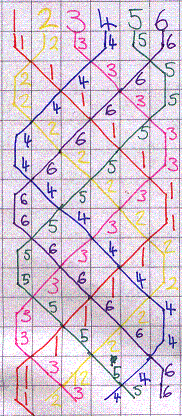Or search by topic
Number and algebra
Geometry and measure
Probability and statistics
Working mathematically
Advanced mathematics
For younger learners
Oranges and Lemons, Say the Bells of St Clement's



- Problem
- Getting Started
- Student Solutions
- Teachers' Resources
We received correct solutions from Alex,
Alice, George, Nell and Tom from Gorseland School, Oliver, Edward,
Alex and Paul from Dartford Grammar School, Katie from Bathurst
West PS, Adam, Annie, Vijay, Louise, Jude, Aaron and Mary from St.
Mary Star of The Sea, Ben from Victoria College, Bethany, Alicia
and Grace from Willaston Primary School, Samantha and Frances from
St. Alban's Catholic Primary School and Max and William from
Brenchley and Matfield School. Well done to you all.
Alex, Alice, George, Nell and Tom sent in this diagram showing the
paths of the six bells:

The pattern of the paths for eight bells was sent by Edward:

Max and William also sent us a solution for twelve bells!
2 4 1 6 3 8 5 10 7 12 9 11
4 2 6 1 8 3 10 5 12 7 11 9
4 6 2 8 1 10 3 12 5 11 7 9
6 4 8 2 10 1 12 3 11 5 9 7
6 8 4 10 2 12 1 11 3 9 5 7
8 6 10 4 12 2 11 1 9 3 7 5
8 10 6 12 4 11 2 9 1 7 3 5
10 8 12 6 11 4 9 2 7 1 5 3
10 12 8 11 6 9 4 7 2 5 1 3
12 10 11 8 9 6 7 4 5 2 3 1
12 11 10 9 8 7 6 5 4 3 2 1
11 12 9 10 7 8 5 6 3 4 1 2
11 9 12 7 10 5 8 3 6 1 4 2
9 11 7 12 5 10 3 8 1 6 2 4
9 7 11 5 12 3 10 1 8 2 6 4
7 9 5 11 3 12 1 10 2 8 4 6
7 5 9 3 11 1 12 2 10 4 8 6
5 7 3 9 1 11 2 12 4 10 6 8
5 3 7 1 9 2 11 4 12 6 10 8
3 5 1 7 2 9 4 11 6 12 8 10
3 1 5 2 7 4 9 6 11 8 12 10
1 3 2 5 4 7 6 9 8 11 10 12
1 2 3 4 5 6 7 8 9 10 11 12
They even tried to find a solution for fifteen bells, but because it is an odd number of bells they weren't able to stick to the rule that on alternate rows we swap all of the bells (in pairs) and on the remaining rows, we fix the bells on either end and swap the rest.
You may also like
Consecutive Numbers
An investigation involving adding and subtracting sets of consecutive numbers. Lots to find out, lots to explore.
Tea Cups
Place the 16 different combinations of cup/saucer in this 4 by 4 arrangement so that no row or column contains more than one cup or saucer of the same colour.
Counting on Letters
The letters of the word ABACUS have been arranged in the shape of a triangle. How many different ways can you find to read the word ABACUS from this triangular pattern?

